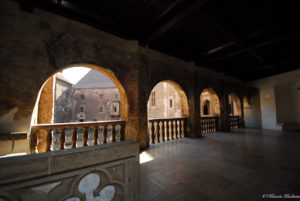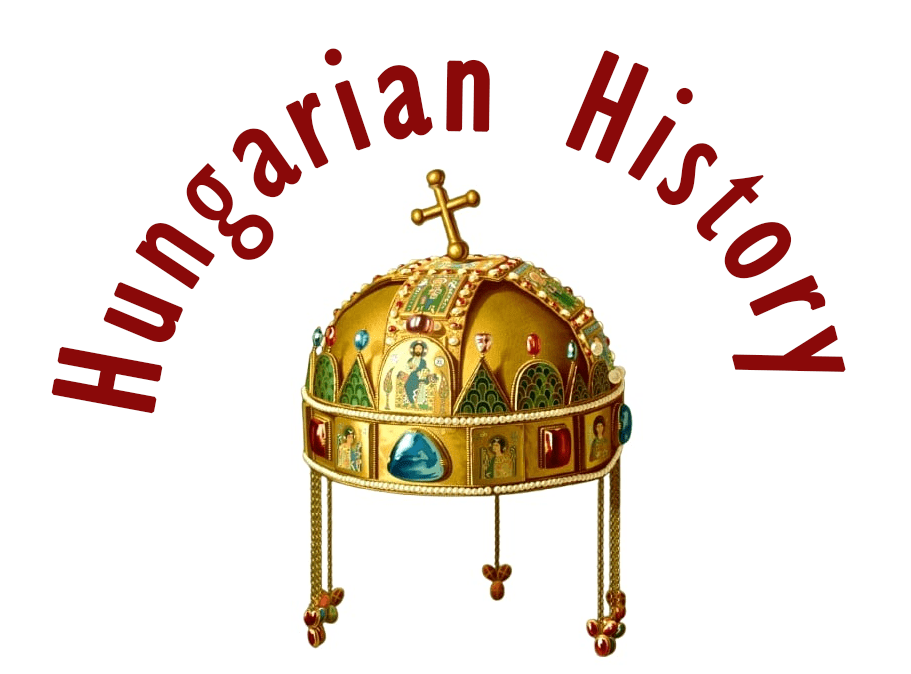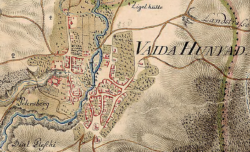Hunyad

The Castle of Hunyadi János
Corvin Castle, also known as Hunyad / Vajdahunyadi Castle or Hunedoara Castle (Romanian: Castelul Huniazilor or Castelul Corvinilor), is a Gothic-Renaissance castle in Hunyad / Hunedoara, in Transylvania, Romania. The Hungarian writer Mikszáth Kálmán said it was the “king of castles” ever built in the Kingdom of Hungary. Location: https://tinyurl.com/2yhfthx2

Since I have written so much about Hunyadi János and his son, King Matthias Corvinus, it is time to introduce you to the castle where the greatest Hungarian king grew up. You can read more about King Matthias Corvinus here:
https://www.hungarianottomanwars.com/essays/king-matthias-corvinus-1443-1490/

The castle is one of the largest in Europe and can be seen today as it was built in its Gothic-Renaissance splendor. It was the Hungarian King Zsigmond of Luxembourg who gave the castle in 1409 to Vajk, the captain of his bodyguard, who began to use the name “Hunyad” as his family name. Vajk’s origins are linked to Wallachia, but rumor has it that he may have been an illegitimate (natural) son of King Zsigmond. This would explain much of his rapid career.

Anyway, his son, Hunyadi János was already named after the castle of Hunyad and he became one of the greatest military leaders of Europe in the 15th century. Hunyadi János is a hero equally loved and claimed by Hungarians, Romanians and Serbs. However, his wife was undoubtedly a Hungarian woman, Szilágyi Erzsébet, and their son, Matthias, was raised by her. (Please note that I use the Eastern name order for Hungarian names, where the surname comes first). Here is more about King Matthias:
https://www.hungarianottomanwars.com/essays/origin-of-king-matthias-corvinus/
The history of the castle

It was the first Christian king of Hungary, István (Stephen), who had the first castle built on St. Péter Hill, a little south of the present castle. This fortress served as the center of the Hunyad County, from where the Comes of the Hungarian kings controlled the area. It was a typical wood and earth castle like the rest of the forts built by the Hungarians during the 10th century. These early fortresses lost their importance after the Mongol invasion of 1242, when stone castles were built on higher ground. The second strongest castle of Hunyad County was Segesd Castle (now in Kolozs County) during the period of the Hungarian-Anjou kings.

The Hunyadi Castle was built in 1446, when the Voivode of Transylvania, Hunyadi János, ordered to rebuild the former keep of King Károly Róbert of Hungary. It was in the same year that Hunyadi János was elected by the Diet as the Regent Governor.

The castle is a large and imposing structure with tall towers, bastions, an inner courtyard, colorful roofs, and countless windows and balconies decorated with stone carvings. The castle also has a double wall for better fortification and is flanked by both rectangular and circular towers, an artistic innovation for Transylvanian architecture at the time.

Some of the towers (the Capistrano Tower, the Deserted Tower, and the Drummers’ Tower) were used as prisons. The Buzogány Tower (the weapon called “buzogány” is a type of mace after which it was named) was built exclusively for defensive purposes and its exterior was decorated with geometric motifs. The rectangular towers have large openings to accommodate larger weapons.

The castle has three large areas: the Knight’s Hall, the Diet Hall, and the circular staircase. The halls are rectangular and decorated with marble. The Diet Hall was used for ceremonies or formal receptions, while the Knight’s Hall was used for banquets. As one of the most important possessions of Hunyadi János, the castle was rebuilt during his reign. It became a luxurious home and not only a strategic point. Over the years, the lords of the castle changed its appearance, adding towers, halls, and guest rooms.

The gallery and the keep – the last defensive tower (called “Neboisa”, which means “Don’t be afraid” in Serbian and Croatian), which remained unchanged from Hunyadi’s time, and the Capistrano Tower (named after the saint, a Franciscan monk from the Battle of Nándorfehérvár / Beograd in 1456) are some of the most significant parts of the building. Other important parts of the building are the Knights’ Hall (a large reception hall), the Club (or Mace) Tower, the White Bastion, which served as a food storage room, and the Diet Hall.
Hunyadi János died in 1456 and the construction of the castle came to a standstill. You can read more about his heroic death here:
https://www.hungarianottomanwars.com/1372-1490/why-can-we-hear-the-bells-at-noon-1456/

In 1458, Lady Szilágyi Erzsébet commissioned the construction of the Matthias wing of the castle. It became the first Renaissance “loggia” in Transylvania. As the residence of King Matthias was either in Visegrád or in Buda, it was his mother, Lady Szilágyi Erzsébet, who stayed in Hunyadi Castle and continued its construction. French and Italian masons and architects were also employed.

In 1480 work on the castle was completely stopped. However, it was recognized as one of the largest and most impressive buildings in Eastern Europe. King Matthias gave the castle to his natural son, Prince Corvin János in 1482. Later, Prince Corvin János had to pledge it to General Kinizsi Pál for money. More about Kinizsi Pál:
https://www.hungarianottomanwars.com/essays/kinizsi-pal-general-of-king-matthias/

The 16th century did not bring any improvements to the castle, but in the 17th century, new additions were made for aesthetic and military purposes. The new Large Palace was built facing the city. A two-story building, it housed a residential chamber and a large living area. For military purposes, two new towers were built: the White Tower and the Artillery Tower. The outer courtyard was also added and used for administration and storage.

In 1601 it was attacked by the Wallachian Voivode Michael, who could not take it either. He could only burn the roofs of the castle and destroy the surroundings. In 1618, the castle became the property of the Bethlen family of Iktár, who renovated and improved it. According to the fashion of the time, they extended it with outer defenses called “Hussar’s Castle”. These new walls protected the raiding and patrolling hussars who were constantly scouting the enemy.

It was connected with the legendary flexible military tactics of the Borderland warriors, who said that “a castle can only be defended on the field”. No wonder that Hussar castles were added to every Borderland castle along the 1,000-mile-long Borderland. You can read more about the Valiant Order, whose members have protected the Borderlands for centuries:
https://www.hungarianottomanwars.com/essays/members-of-the-valiant-order/

Lady Széchy Mária lived here for a short time in 1632. Several guilds worked in the town: tailors, plowmen, shoemakers, and furriers. The Reformed Church was established here in 1634. We know that the castle was owned by the wealthy Thököly family in the 17th century, and Prince Thököly Imre stayed in Hunyadi Castle several times.

It was the Transylvanian Prince Apafi who took the castle in 1685. The Habsburgs were able to acquire the property in 1725. The last military action connected with Hunyadi Castle was in 1784, when the Romanian peasants, led by Horea, rebelled. The local nobles took refuge in the old fortress and were able to repel all attacks.

The Habsburg Emperor Franz II happened to visit the castle in 1817 and donated 30,000 gold forints for its renovation. Unfortunately, the restoration was mostly in vain, because in 1823 the roof was destroyed by thunder and had to be covered with temporary roofs. The buildings burned down again in 1854, and it was not until 1868 that efforts were made to restore the magnificent knight’s castle. Unfortunately, many of the new sections were the product of the imagination of an architect named Steind Imre. Fortunately, between 1907 and 1913 a historically correct renovation was carried out by Möller István.

The 20th century brought some changes to the area, as you can see: an ugly chemical industry was built around the beautiful fort. The good news is that the factory was closed in 2003. The restoration of the castle, supervised by the Romanian state, began in 1956.

Legends…
It should be noted that the castle has nothing to do with Dracula and other fictional monsters. In the courtyard of the castle, near the 15th-century chapel, there is a 30-meter-deep well. Legend has it that this well was dug by three Turkish prisoners who were promised freedom by János Hunyadi if they could reach the water. After 15 years they dug the well, but Hunyadi died and Szilágyi Erzsébet did not keep his promise.
At that time the Turks were a risk because they knew too much about the weaknesses of the castle. It is said that the inscription on the wall of the well means “You have water but no soul”. However, specialists have translated the Arabic inscription as “The one who wrote this inscription is Hasan, who lives as a slave of the Giaours (infidels) in the fortress near the church”.

Here is a video about the castle from the sky:
https://www.youtube.com/watch?v=cPAlPQcEQI8

Dear Readers, I can only make this content available through small donations or by selling my books or T-shirts:
Please, feel free to support me with a coffee here: You can check out my books on Amazon or Draft2Digital, they are available in hardcover, paperback, or ebook: https://www.amazon.com/dp/198020490X or at https://books2read.com/b/boYd81

My work can also be followed and supported on Patreon: Become a Patron!http://Become a Patron!

Here are many more pictures of Vajdahunyadi castle:








































